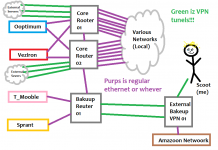
Edit: ACTUALLY, NEVERMIND It’s now June of 2020, and I figure it’s time to put a big “disregard” in the title of this post. While my objectives were indeed grand, there’s a fundamental flaw in my methodology: Most of the UPSes in question do not perform battery self-tests. As such, I really only find out about bad batteries when there’s an actual power failure. And those happen very inconsistently, and infrequently. (Which is good for me overall, but bad for this “log”.) For example, my power just flickered briefly and one UPS shut down as soon as the power went off. The batteries were dated as replaced on 2017-12-10. However, that UPS survived the last power outage some months ago, … Continue reading













